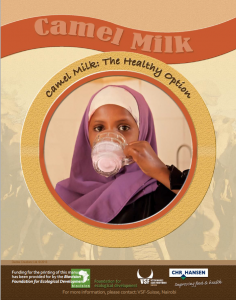
Good quality milk comes from clean healthy animals, whether camel, cow or goat. Milk from sick animals often carry diseases along, which results in unattractive taste of the milk as well as storage problems. Milk from sick animals does not keep well. Dirty milk does not keep well. If an animal has been treated with antibiotics or trypanosomes, this will be evident in the milk and is dangerous for people to consume, so withdrawal instructions must be respected.
Milk Composition

2007. Note; Much higher vitamin C and Insulin content in camel milk compared to
cow milk.
- Good quality milk is:
- Has a fresh clean smell,
- Looks clean
- Is free from contaminants such as dirt, etc.,
- Is stored in a clean attractive container
Taste issues:
Clean healthy milk has a fresh, clean, sweet (for camel milk at times slightly salty) taste, which is highly preferred by customers.
Bitter taste can be caused by:
- Camels eating bitter herbs,
- Milk from camels in late lactation changes taste to become less sweet.
Unclean (various shades of rotten) taste is most often caused by:
- Dirt in the milk,
- Mastitis present in the milk.
Smell issues:
All milk consumers learn quickly to smell the quality of milk. Fresh clean milk smells fresh and clean and boiled milk has its own aroma.
Unpleasant smell can be caused by:
- Contamination with dirt (smell of manure).
- Mastitis (can give a slightly sickly smell).
- acaricide that is applied to the udder for tick control. There have been cases of poisoning after consumption of such milk.
- Spoilage of milk. Various spoilage bacteria can give various odors.
Sour smell is caused by the beginning fermentation of the milk. This can be pleasant or unpleasant depending on consumer preference.
Contamination issues:
As customers all over clearly prefer clean milk, efforts should be made to make sure no contaminants enter the milk. A sterilised tea sieve with small holed netting is a useful tool for straining milk after milking to avoid sending milk to market with contamination by any dirt.
Containers:
All milk containers must be clean and attractive looking to encourage customer confidence. See chapter on Milk Quality.
Healthy milk
Healthy milk does not pose a threat to consumers. Thus healthy milk is free from:
Diseases transmitted to humans through camel milk
Milk is a near perfectfood for humans, animals as well as microorganisms. Milk can transfer disease germs from animal or person/milker/handler to customers if not boiled or pasteurised. The following diseases are transferable in milk:
- Brucellosis (instantaneous abortion fever) affects people and animals alike. In people the fever, which may feel like a bad case of malaria, gives symptoms such as headache, fever, joint pains, general fatigue, and in pregnant women – abortion. The cure after proper diagnosis in the lab is a long expensive treatment with antibiotics. Animals may be vaccinated against this disease. Brucellosis is common in ASAL areas both in animals and people.
Brucellosis and Tuberculosis (TB) can be transmitted through uterine discharge and urine which may contaminate milk and milker’s hands. Milkers should therefore Not touch urine, retained after birth or aborted fetuses as these can all transmit Brucellosis and TB.
- Tuberculosis.Any milker who has TB can transfer this disease to the milk via hands, sneezing or even breathing onto the milk. TB is common in ASAL areas especially in people.
Camels can also be carriers of tuberculosis and transmit it to people drinking raw camel milk:Tuberculosis is known to affect all species of livestock. Camels can transmit it to humans via milk especially to children.
- Scarlet fever
- Cholera
- Q-fever
- Dysentery
- Diphtheria
- Typhoid
- Mastitis.This is an infection of the udder of the animal, and all milk producing animals (as well as humans) can become infected. The presence of mastitis in milk will give a very tainted taste, which does not disappear after boiling, so will discourage consumers from buying.
Please note:
- The threat of disease transfer is removed if the milk is boiled or pasteurised.
- Many milk sellers have discovered that customers actually prefer boiled milk, as it is safer for their families to consume.